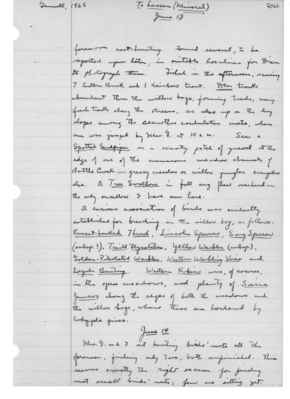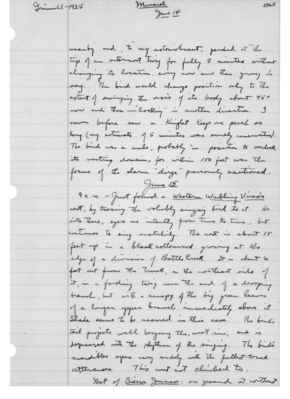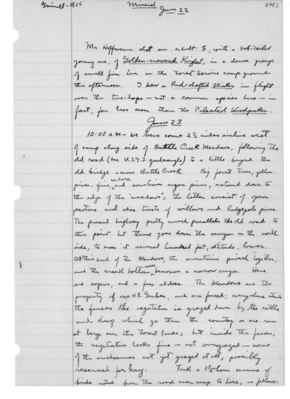Pages That Mention Battle Creek
1925: Joseph Grinnell's field notes
S2 Page 6
Collector: Grinnell - 1925 Location: Lassen Section (Mineral) Date: June 13-14, 1925 Page Number: 2462
forenoon nest-hunting. Found several, to be reported upon later, in suitable locations for Dixon to photograph them. Fished in the afternoon, securing 7 Eastern Brook and 1 Rainbow Trout. Deer tracks abundant thru the willow bogs, forming trails; many fresh tracks along the streams, as also up on the dry slopes among the Ceanothus cordulatus mats, where one was jumped by Mrs. G at 10 a.m. Saw a Spotted Sandpiper on a scanty patch of gravel at the edge of one of the numerous meadow channels of Battle Creek - grassy meadows on willow jungles everywhere else. A Tree Swallow in full song flew overhead - the only swallow I have seen here. A curious association of birds was evidently established for birding in the willow bog, as follows: Russet-backed Thrush, Lincoln Sparrow, Song Sparrow (subsp.?), Traill Flycatcher, Yellow Warbler (subsp.), Golden-Pileolated Warbler, Western Warbling Vireo and Lazuli Bunting. Western Robins were, of course, in the open meadows, and plenty of Sierra Juncos along the edges of both the meadows and the willow bogs, where these are bordered by lodgepole pines. June 14 Mrs. G. and I out hunting birds' nests all the forenoon, finding only two, both unfinished. This seems exactly the right season for finding most small birds' nests; few are sitting yet.
S2 Page 9
Collector: Grinnell - 1925 Location: Lassen Section (Mineral) Date: June 14-15, 1925 Page Number: 2465
nearby and, to my astonishment, perched at the top of an outermost twig for fully 5 minutes without changing its location, every now and then giving its song. The bird would change position only to the extent of swinging the axis of its body about 45° now and then - "looking" in another direction. I never before saw a Kinglet keep one perch so long (my estimate 15 minutes was surely conservative). The bird was a male, probably in position to overlook its nesting domain, for within 100 feet was the focus of the alarm "dinge" previously mentioned. June 15 9 a.m. - Just found a Western Warbling Vireo's nest, by tracing the volubly singing bird to it. He sits there, eyes me intently from time to time, but continues to sing snatchily. The nest is about 18 feet up in a black cottonwood growing at the edge of a division of Battle Creek. It is about 6 feet out from the trunk, on the northeast side of it, in a forking twig near the end of a drooping branch, but with a canopy of the big green leaves of a longer upper branch immediately above it. Shade seems to be assured in this case. The birds' tail projects well beyond the nest rim, and is depressed with the rhythm of the singing. The birds' mandibles open very widely with the fullest-toned utterances. This nest not climbed to. Nest of Sierra Junco: on ground at northeast.
S2 Page 38
Collector: Grinnell - 1925 Location: Mineral Date: June 22 Page Number: 2492
Mr. Hoffmann shot an adult male, with a bob-tailed young one, of Golden-crowned Kinglet, in a dense group of small fir here on the Forest Service camp ground this afternoon. I saw a Red-shafted Flicker in flight over the tree-tops - not a common species here - in fact, far less seen than the Pileated Woodpecker.
June 23 10:00 a.m. - we have come 2 1/2 miles airline west of camp along side of Battle Creek Meadows, following the old road (see U.S.G.S quadrangle) to a little beyond the old bridge across Battle Creek. Big forest trees, yellow pines, fir, cedars, and sometimes sugar pines, extend down to the edge of the "meadows"; the latter consist of open pasture and also tracts of willows and lodgepole pines. The present highway pretty much parallels the old road to this point but thence goes down the canyon on the north side, to cross it several hundred feet, altitude, lower. At this end of the Meadows, the mountains pinch together, and the creek bottom ^soon becomes a narrow canyon. Here are aspens, and a few alders. The Meadows are the property of one W. L. Gerber (?), and are fenced; everywhere astride the fences the vegetation is grazed down by the cattle and sheep which go thru [sic] the country or are seen at large over the forest lands; but inside the fences, the vegetation looks fine - not overgrazed - some of the enclosures not yet grazed at all, possibly reserved for hay. Took a 1 1/2 hour census of birds notes from the road near camp to here, as follows:


